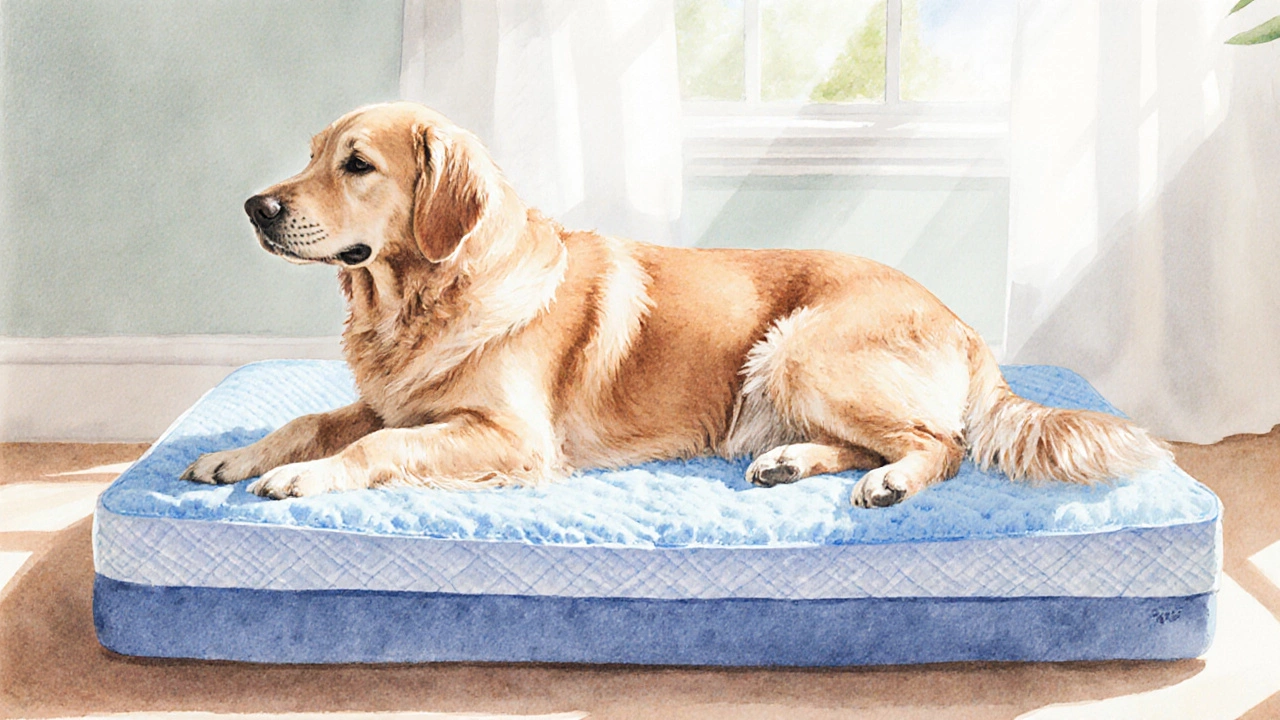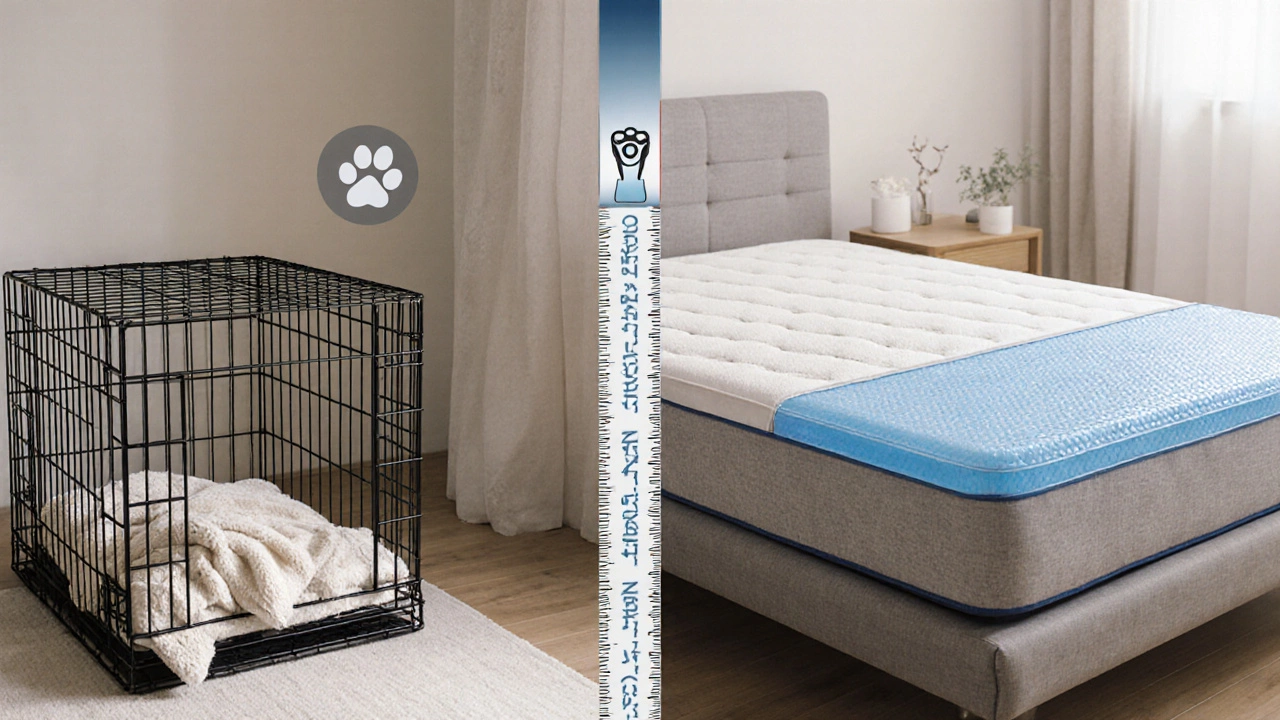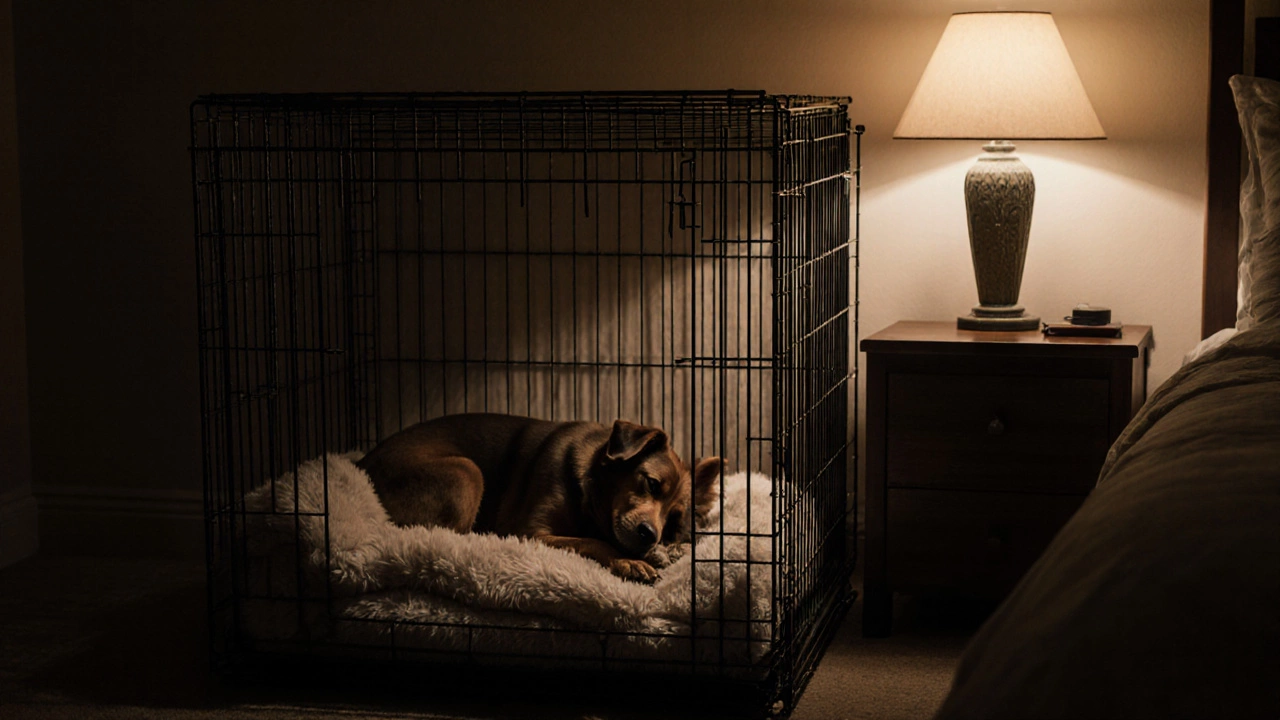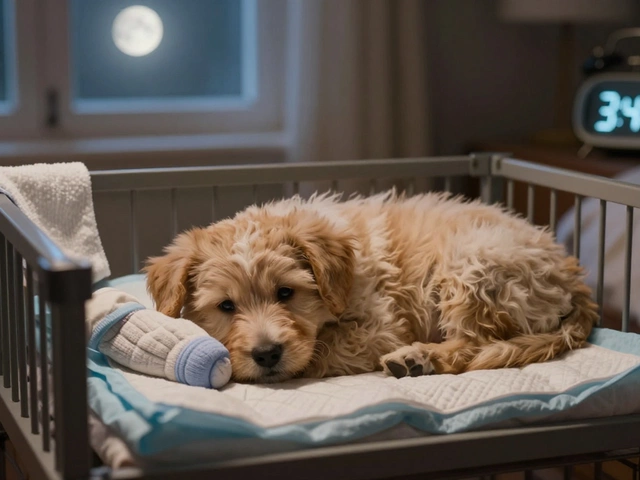Dog Crate vs Bed Decision Tool
This tool helps you decide whether a crate or bed best suits your dog's needs. Answer these questions based on your dog's specific situation to get a personalized recommendation.
Your Dog's Profile
Recommendation
When deciding where your pup should spend the night, dog crate is a closed, confinement‑style sleeping area designed to mimic a den often competes with a dog bed that offers an open, cushioned surface for lounging. Both options promise comfort, safety, and a sense of ownership, but they serve very different instincts and practical needs. This guide breaks down the science, the pros and cons, and the key factors that help you choose the right night‑time spot for your dog.
What a Dog Really Wants When It Sleeps
Domestic dogs trace their sleeping habits back to the Den Instinct. In the wild, wolves curl up in tight, dark spaces to protect themselves from predators and preserve body heat. That instinct translates into a modern preference for enclosed, low‑light areas - exactly what a well‑ventilated crate provides.
At the same time, dogs also enjoy the ability to stretch out and relax on soft surfaces, especially as they age or after a day of activity. This is where a Orthopedic Dog Bed shines, offering pressure‑relief for joints and muscles.
Understanding this dual nature helps you decide whether confinement (crate) or cushion (bed) will better support your pet’s Sleep Cycle and overall wellbeing.
Advantages of a Dog Crate
- Safety and containment: A crate prevents nighttime accidents, keeps your dog away from hazardous objects, and can reduce chewing or wandering.
- Crate Training benefits: Consistent crate use creates a predictable routine, which can ease separation Anxiety and reinforce house‑breaking.
- Temperature regulation: Many crates are made of metal or breathable fabric, allowing airflow that keeps dogs cool in summer and, when paired with a blanket, warm in winter.
- Portability: A travel‑ready crate can double as a carrier, making trips to the vet or on holiday hassle‑free.
These strengths align well with dogs that thrive on routine, have a strong Den Instinct, or need a secure sleeping environment due to health or behavioral issues.
Drawbacks of a Dog Crate
- Limited space can feel restrictive for larger breeds or dogs with joint problems.
- Without proper bedding, crates can become cold or hard, negating comfort.
- Overuse may lead to increased stress if the dog associates the crate with punishment.
To avoid these pitfalls, introduce the crate gradually, use a soft blanket, and keep crate sessions short at first.

Advantages of a Dog Bed
- Comfort and joint support: Orthopedic foam or memory‑foam beds distribute weight evenly, easing pressure on hips, elbows, and spine.
- Freedom of movement: Dogs can stretch, roll, and change positions, which matches natural sleep patterns.
- Temperature control: Many beds feature breathable covers or cooling gels, helping dogs stay comfortable in hot climates.
- Easy cleaning: Removable, washable covers simplify hygiene for households with allergies.
Beds are especially beneficial for senior dogs, large breeds, and pups with arthritis or chronic pain.
Drawbacks of a Dog Bed
- Without a defined boundary, some dogs wander off or climb onto furniture.
- Chewers may destroy softer beds quickly, leading to costly replacements.
- In homes with multiple pets, a single bed may become a contested resource.
Choosing a durable Material Durability (e.g., rip‑stop nylon or reinforced stitching) can mitigate the wear‑and‑tear issue.
How to Choose the Right Option for Your Dog
Rather than asking "crate or bed?" ask yourself a series of practical questions. Below is a quick decision matrix that blends instinct, health, and lifestyle.
| Factor | Dog Crate | Dog Bed |
|---|---|---|
| Safety | High - enclosed, prevents roaming | Medium - open, relies on supervision |
| Comfort for joint issues | Depends on padding added | High - orthopedic foam available |
| Space needs | Compact, fits under furniture | Requires floor area; larger for big breeds |
| Training aid | Excellent for crate training and house‑breaking | Minimal |
| Cost | Low‑to‑medium (basic crate $30‑$80) | Medium‑to‑high (orthopedic bed $50‑$200) |
Use the matrix to match your dog’s primary needs. For example, a young, high‑energy Labrador may benefit from the security of a crate while learning house rules, whereas a senior Golden Retriever with arthritis will likely thrive on an orthopedic bed.

Key Factors to Measure Before Buying
- Size Guidelines: Measure your dog’s length from nose to base of tail and add a few inches; the sleeping surface should allow the dog to stretch fully. Most manufacturers provide breed‑specific charts.
- Material: Look for non‑toxic, chew‑resistant fabrics. For crates, metal with a powder‑coated finish resists rust. For beds, high‑density memory foam paired with a removable cotton cover offers durability and hygiene.
- Location: Place the crate in a low‑traffic, quiet corner with a blanket for warmth. Position the bed in a drafts‑free area but where the dog can still observe family activity if it prefers social monitoring.
- Temperature Regulation: In hot climates, choose a ventilated crate or a bed with cooling gel. In colder regions, add a self‑warming pad or a cozy blanket.
- Behavioral cues: If your dog shows signs of stress when confined, start with a crate that’s slightly larger and gradually introduce a blanket. If the dog jumps on furniture constantly, a low‑profile bed may reduce the urge.
Transition Tips - Making the Switch Smooth
- Introduce the new sleeping spot beside the old one for a week; let the dog explore freely.
- Place a favorite toy or a piece of your clothing in the crate or bed to add scent comfort.
- Reward calm behavior with treats and praise, reinforcing the positive association.
- Keep a consistent bedtime routine - a short walk, a bathroom break, then settle into the chosen spot.
- Monitor for signs of anxiety or discomfort (excessive barking, pacing, or refusing to lie down) and adjust accordingly.
Remember, the goal isn’t to force a preference but to create an environment where your dog feels safe, rested, and ready for daytime adventures.
Frequently Asked Questions
Can I use a crate and a bed together?
Yes. Many owners place a soft bed or blanket inside the crate. This gives the security of the enclosure while adding the comfort of cushioning, ideal for puppies and senior dogs.
How big should a crate be for a medium‑sized dog?
Measure your dog’s length from nose to tail base, then add 2‑4 inches. For most medium breeds (e.g., Border Collie, Beagle), a 30‑inch crate works well. The dog should be able to stand, turn around, and lie down comfortably.
Is crate training harmful to a dog’s mental health?
When used correctly, crate training is not harmful. It should never be a punishment tool, and dogs should not spend excessive time confined-generally no more than a few hours at a stretch during the night.
What type of bed is best for a dog with arthritis?
An orthopedic dog bed with high‑density memory foam or gel‑infused foam provides firm yet pressure‑relieving support, which can ease joint pain and improve sleep quality for arthritic dogs.
How do I keep my dog from chewing a crate?
Choose a crate made of sturdy metal or heavy‑duty plastic. Provide chew‑safe toys before bedtime and ensure the dog gets enough mental and physical stimulation during the day to reduce boredom‑driven chewing.





